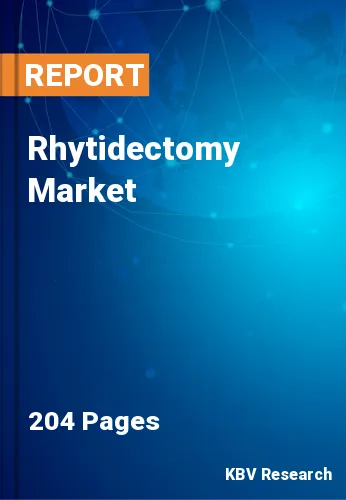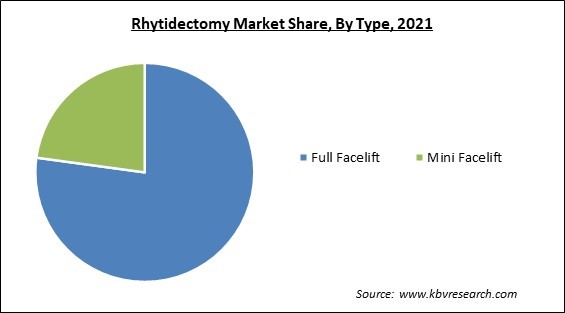
The Global Rhytidectomy Market size is expected to reach $4.3 billion by 2028, rising at a market growth of 8.4% CAGR during the forecast period.
Rhytidectomy is a cosmetic procedure used to remove extra facial skin, redrape the skin, tone the facial muscles, and tighten the underlying tissues to give the patient a more youthful appearance. Rhytidectomy is more commonly referred to as a facelift. The fundamental urge to remain young is a major factor propelling the worldwide rhytidectomy market. Rhytidectomy ranks as the sixth most popular cosmetic operation, behind breast augmentation, liposuction, abdominoplasty, eyelid surgery, and breast lift, as stated by the American Society for Aesthetic Plastic Surgery.

The rhytidectomy market is extremely sensitive to various social and cultural issues, as well as the media's and the fashion industry's impact, peer pressure for attractiveness, and shifting definitions of beauty, amongst many others. The market is driven by the rise in elderly people, particularly the baby boomer generation. A skin flap on each face side is pulled back during a rhytidectomy or facelift. In addition to removing extra skin, tissues beneath the skin are changed. This shapes the face to look younger.
Frequently, a facelift includes a neck lift. On the neck, it minimizes fat and sagging skin. As people age, their faces alter in appearance and structure. Skin starts to sag and doesn't recover as quickly. Some parts of the face's fat deposits decrease, while others see an increase. Some common age-related changes that can be addressed with a facelift include cheeks that appear to be sagging, the lower jawline's extra skin, and deep skin folds extending from the mouth’s corners to the nose’s sides.
Most of the demand for rhytidectomy arises in nations that are majorly known for medical tourism. Therefore, the tourism industry has a share that is out of proportion to its size. For instance, due to their robust tourism industries, tourist hotspots like Miami, Pattaya, Bangkok, and Venezuela perform disproportionately high facelift operations. More FDA approvals are fueling the growth and expansion of the rhytidectomy market. Additionally, the U.S. FDA's approval of fibrin sealants and the appearance of healing creams have further bolstered demand.
As a result, the number of facelift procedures grew in 2021, according to a report by the Aesthetic Plastic Surgery National Data Bank. The average time spent on video conference calls increased due to remote employment. As a result, individuals focused far too much on their outward looks, because of which the market saw a boom, and this trend is anticipated to continue for some time. In addition, demand for aesthetic procedures emerged in developing nations due to the rising health and well-being consciousness. Therefore, the pandemic had a positive impact on the rhytidectomy market.
Increasing numbers of hospitals and clinics can now perform cosmetic operations owing to technological advancements in advanced diagnostic imaging technology. The demand for facelifts is anticipated to be driven by the development of computer-generated figures, which provide a quick perspective of the procedure on the patients. Technological developments, including magnetic resonance imaging, computed tomography, and others, simplify the surgery process. In addition, the creation of computer-generated models gives patients a quick glimpse of the procedure's results.
The adoption of social media by youngsters is commonplace worldwide. People aim to look appealing on social networking as well as dating websites. Also, many people have had cosmetic surgery due to social media influence. Many single and divorced women and men have been choosing cosmetic surgery over the past few years. Women need to seem beautiful and are prepared to spend money to do so, especially those who are part of elite circles. In addition, some people find themselves captivated by the extravagant lifestyles of famous people and want to live like them. These elements are therefore anticipated to fuel the expansion of the rhytidectomy market during the upcoming years.
Complications from a facelift operation are possible. While uncommon, long-term or permanent issues might alter a person's look. The most frequent facelift consequence is a hematoma or accumulation of blood under the skin. Swelling and pressure are symptoms of a hematoma. During a day of surgery, it typically forms. A facelift's incision scars are irreversible. However, the hairline and the normal outlines of the face and ear usually conceal them. As a result, incisions can occasionally leave elevated scars. Scars may look better after receiving doses of a corticosteroid drug or after undergoing other procedures.
Based on type, the rhytidectomy market is categorized into full facelift and mini facelift. The mini facelift segment procured a considerable growth rate in the rhytidectomy market in 2021. The neck and lower face are lifted during mini-facelift operations. Compared to other facelift procedures, it is less time-consuming and intrusive. As a result, doctors frequently advice mini facelifts when a patient is younger and just shows mild signs of facial sagging. The procedure's effectiveness, quick recovery time, and cost-efficiency are credited for expanding the segment.
On the basis of age group, the rhytidectomy market is divided into 30 - 39 years, 40 - 54 years, 55 - 69 years, and 70 years and above. The 55 - 69 years segment acquired the largest revenue share in the rhytidectomy market in 2021. Since face aging is more prevalent in this age group, the 55 to 69 years segment undergo facelift surgeries the most. The increase in spending power and the growing desire to seem young are credited with driving this market. In accordance with the Plastic Surgery Statistics Report 2020, facelift procedures accounted for 234,374 procedures, 149,970 of which were carried out on older patients between the ages of 55 and 69.
Based on gender, the rhytidectomy market is segmented into male and female. The female segment witnessed the maximum revenue share in the rhytidectomy market in 2021. This is explained by the female population's growing understanding of the advantages of rhytidectomy. As reported by the International Society of Aesthetic Plastic Surgery, two hundred sixteen thousand three hundred fifty female facelift surgeries were performed overall. The demand for facelift operations in this market has also increased due to the female populations growing per capita income and rising desire to look beautiful.

On the basis of end-use, the rhytidectomy market is fragmented into hospitals, clinics, and others. The clinics segment acquired a substantial revenue share in the rhytidectomy market in 2021. According to the Plastic Surgery Statistics Report, approximately 5,846,488 surgeries were conducted in clinics in 2020. Many people prefer specialized clinics as these usually can-do multiple surgeries in one sitting. In addition, with the development of technology, most clinics now offer the same level of comfort before and after procedures. All these factors propel the growth of the segment.
| Report Attribute | Details |
|---|---|
| Market size value in 2021 | USD 2.5 Billion |
| Market size forecast in 2028 | USD 4.3 Billion |
| Base Year | 2021 |
| Historical Period | 2018 to 2020 |
| Forecast Period | 2022 to 2028 |
| Revenue Growth Rate | CAGR of 8.4% from 2022 to 2028 |
| Number of Pages | 204 |
| Number of Table | 427 |
| Report coverage | Market Trends, Revenue Estimation and Forecast, Segmentation Analysis, Regional and Country Breakdown, Companies Strategic Developments, Company Profiling |
| Segments covered | Age Group, Gender, Type, End-use, Region |
| Country scope | US, Canada, Mexico, Germany, UK, France, Russia, Spain, Italy, China, Japan, India, South Korea, Singapore, Malaysia, Brazil, Argentina, UAE, Saudi Arabia, South Africa, Nigeria |
| Growth Drivers |
|
| Restraints |
|
Region wise, the rhytidectomy market is analyzed across North America, Europe, Asia Pacific, and LAMEA. The North America region recorded the largest revenue share in the rhytidectomy market in 2021. Due to the region's technologically superior infrastructure, increased per capita spending, and widespread use of facelift operations among all age groups, the market has been growing. Also, clearly defined reimbursement regulations are accelerating this region's industrial growth. High levels of patient knowledge, increased desire for less invasive procedures, and upgraded healthcare infrastructure for facial procedures are other growth accelerators for the regional industry.
Free Valuable Insights: Global Rhytidectomy Market size to reach USD 4.3 Billion by 2028
The market research report covers the analysis of key stake holders of the market. Key companies profiled in the report include London Bridge Plastic Surgery, Piedmont Plastic Surgery & Dermatology, The Plastic Surgery Center, USA Health, ASET Hospital, Enhance Medical Group and BSR ENT Hospital.
By Age Group
By Type
By Gender
By End-use
By Geography
The global Rhytidectomy Market size is expected to reach $4.3 billion by 2028.
Social networking and the fashionable world's growing influence are driving the market in coming years, however, Occurrence of severe complications after surgery restraints the growth of the market.
London Bridge Plastic Surgery, Piedmont Plastic Surgery & Dermatology, The Plastic Surgery Center, USA Health, ASET Hospital, Enhance Medical Group and BSR ENT Hospital.
The Hospitals segment acquired maximum revenue share in the Global Rhytidectomy Market by End-use in 2021 thereby, achieving a market value of $1.8 billion by 2028.
The Full Facelift segment is leading the Global Rhytidectomy Market by Type in 2021 thereby, achieving a market value of $3.2 billion by 2028.
The North America market dominated the Global Rhytidectomy Market by Region in 2021, and would continue to be a dominant market till 2028; thereby, achieving a market value of $1.5 billion by 2028.
Our team of dedicated experts can provide you with attractive expansion opportunities for your business.
